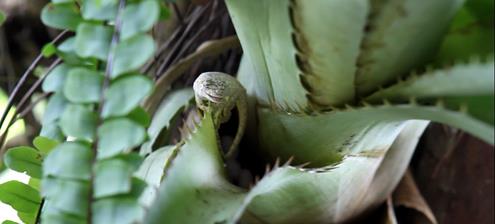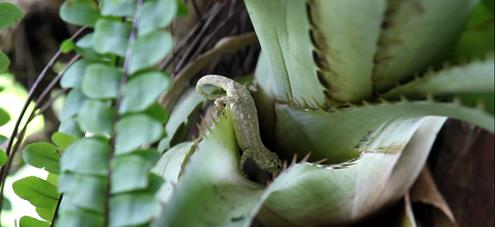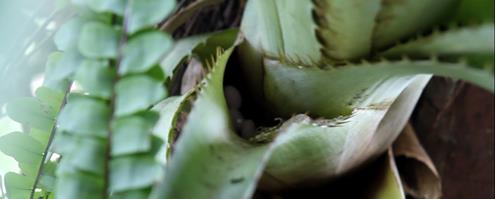

| Online: | |
| Visits: | |
| Stories: |
The Lichen Anole and Evidence for Parental Care
During an excursion with Indigo Expeditions to Estación Biológica Las Guacamayas, Parque Nacional Laguna del Tigre, Guatemala, we observed the unusual behaviour of a female Lichen Anole Anolis beckeri (previously Anolis/Norops pentaprion), a rarely-studied, canopy-dwelling, anole from Central America. In a paper in Mesoamerican Herpetology, we report on observing a female A. beckeri potentially tending and guarding eggs. This is possibly also an example of oviposition site fidelity in an anole.
Seven unknown lizard eggs were first discovered on 9th July 2015. The eggs were deposited in the leaves of a bromeliad plant (Bromelia sp.) roughly 5m above the ground. The lichen anole is typically a canopy-dwelling species but, luckily for us, the bromeliad was in a tree at eye level to one of the research station’s balconies! The bromeliad plant had collected water and one egg in particular, lying partially submerged, was a brown, speckled colour. Another of the eggs appeared indented, a sign of potential imminent hatching. The female A. beckeri deposited an additional egg after our return to the UK, which reflects similar egg laying pattern for Anolis where independent, single eggs are laid every 5–25 days during the breeding season (Losos, 2009).
Over the next few days there were no changes in the eggs’ shapes or colour. It wasn’t until 3 days later, on the 12th of July, that we finally witnessed the owner of these eggs: a female A. beckeri sat above the clutch on one of the fronds of the bromeliad. The anole was seen repeatedly climbing into the bromeliad, seemingly to examine the eggs. She would then lick them and exhale heavily over them (perhaps to increase airflow?), before retreating to the top of the bromeliad. She repeated this sequence of behaviours, retreating to safety up the tree and then re-emerging to check on the eggs numerous times.
We recorded these behaviours on video and in photographs from a distance, to avoid disturbing the lizard. The female returned on numerous occasions to examine, lick and ‘aerate’ the eggs or to seemingly guard the eggs over the next few days but on the 14th of July the female only monitored the eggs from a distance of ca. 30 cm away and did not approach them.
We also witnessed potential predatory behaviour from a Mexican Parrot Snake (Leptophis mexicanus), On the 15th July the snake was seen in the vicinity of the clutch, perhaps attempting to prey on the adult female. See full paper for detail.
These observations offer insight into the life history and behaviour of this rarely-seen anole species. Hopefully, with the continued work of Indigo Expeditions and the guides at Estación Biológica Las Guacamayas we’ll learn more about these interesting reproductive behaviours in the future.
Source: http://www.anoleannals.org/2017/04/05/the-lichen-anole-and-evidence-for-parental-care/







